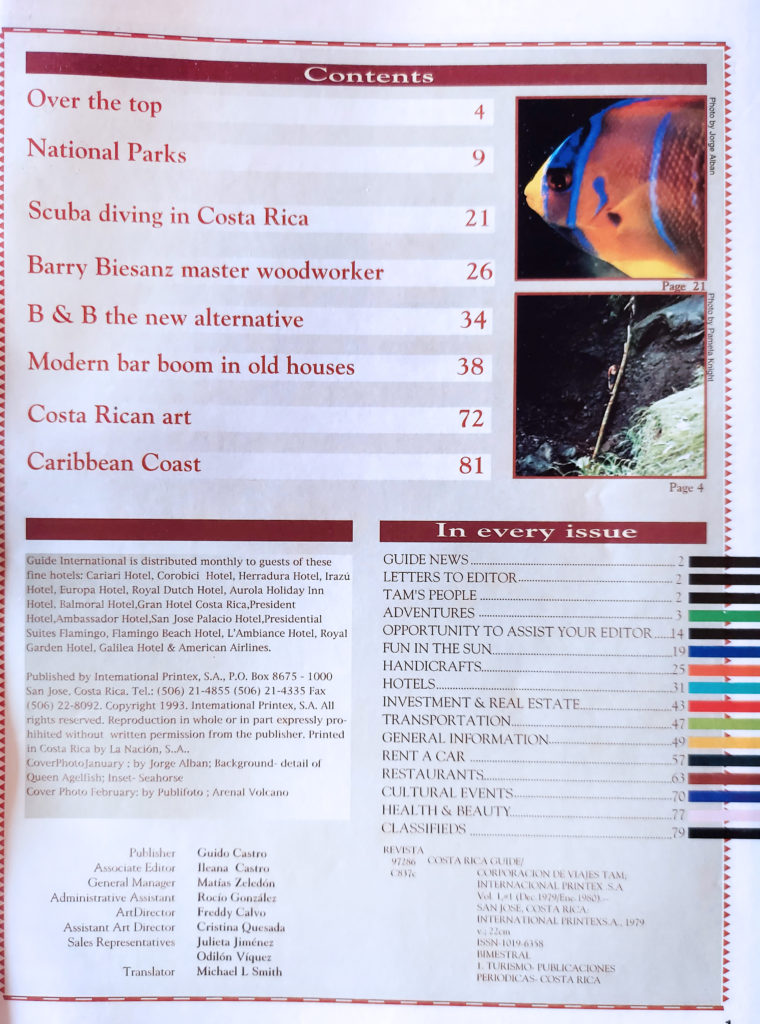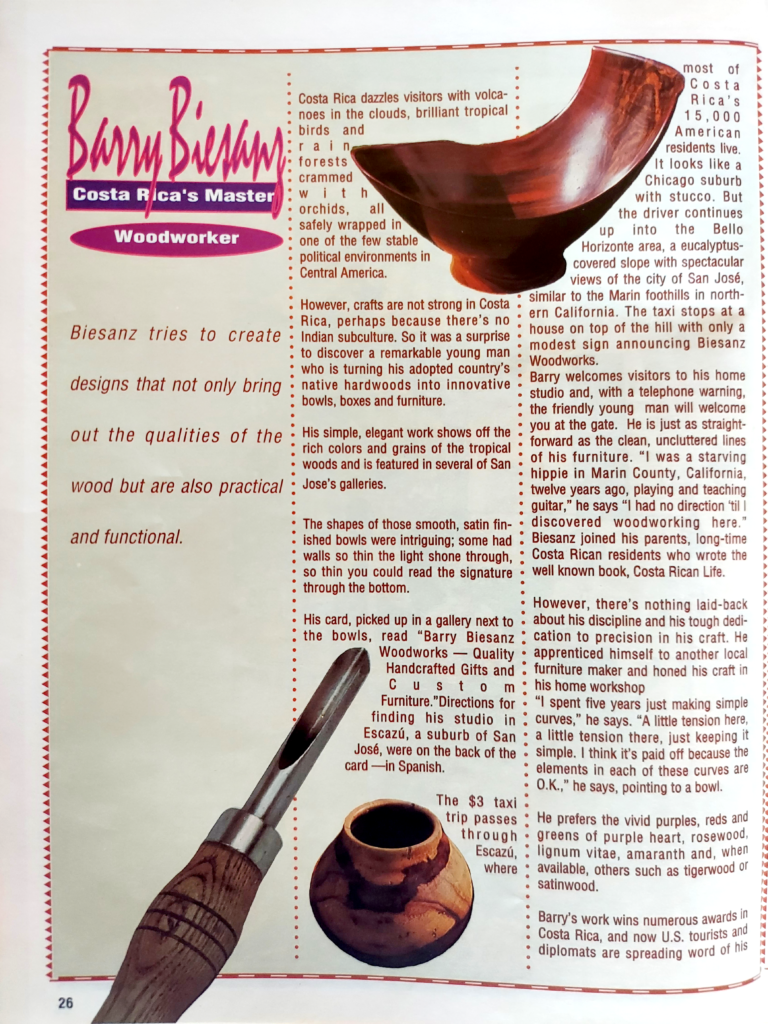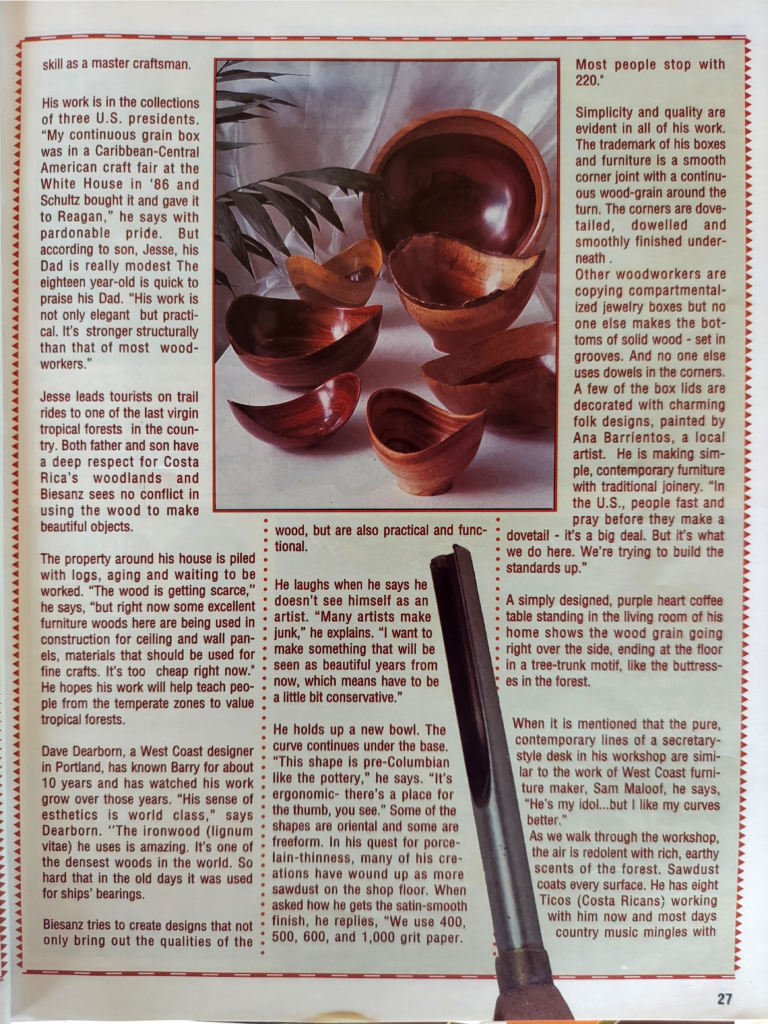Barry Biesanz Master Woodworker - Guide Magazine 1993





Guide Magazine, published by American Airlines, 1993
Barry Biesanz, Costa Rica’s Master Woodworker
Costa Rica dazzles visitors with volcanoes in the clouds, brilliant tropical birds and rainforests crammed with orchids, all safely wrapped in one of the few stable political environments in Central America.
However, crafts are not strong in Costa Rica, perhaps because there is no Indian subculture. So it was a surprise to discover a remarkable young man who is turning his adopted country’s native hardwoods into innovative bowls, boxes and furniture.
His simple, elegant work shows off the rich colors and grains of the tropical woods and is featured in several of San Jose’s galleries. The shapes of those smooth, satin-finished bowls were intriguing; some had walls so thin the light showed through, so thin you could read the signature through the bottom.
His card, picked up in a gallery next to the bowls, read “Barry Biesanz Woodworks — Quality Handcrafted Gifts and Custom Furniture”. Directions for finding his studio in Escazú, a suburb of San José were on the back of the card – in Spanish.
The $3 taxi trip passes through Escazú, where most of Costa Rica’s 15,000 American residents live. It looks like a Chicago suburb with stucco. But the driver continues up into the Bello Horizonte area, a eucalyptus covered slope with spectacular views of the city of San José, similar to the Marin foothills in northern California. The taxi stops at a house on the top of the hill with only a modest sign announcing Biesanz Woodworks.
Barry welcomes visitors to his home studio and, with a telephone warning, the friendly young man will welcome you at the gate. He is just as straightforward as the clean, uncluttered lines of his furniture. “I was a starving hippy in Marin County, California, playing and teaching guitar,” he says. I had no direction ’til I discovered woodworking here. Biesanz joined his parents, long time Costa Rican residents who wrote the well known book Costa Rican Life.
However there is nothing laid back about his discipline and tough dedication to precision in his craft. He apprenticed himself to another local furniture maker and honed his craft in his home workshop.
“I spent five years just making simple curves,” he says. “A little tension here, a little tension there, just keeping it simple. I think it’s paid off because the elements in each of these curves is O.K.,” he says, pointing to a bowl.
He prefers the vivid purples, reds, and greens of purpleheart, rosewood, lignum vitae, amaranth, and when available, others such as tigerwood or satinwood.
Biesanz’ work wins numerous awards in Costa Rica, and now US tourists and diplomats are spreading word of his skill as a master craftsman. His work is in the collections of three US presidents. “My continuous grain box was in the Caribbean-Central American craft fair at the White House in ’86 and Schultz bought it and gave it to Reagan,” he says with pardonable pride. But according to son Jesse, his Dad is really modest.
The eighteen-year-old is quick to praise his Dad. “His work is not only elegant but practical. It’s stronger structurally than that of most woodworkers.”
Jesse leads tourists on trail rides to one of the last virgin tropical forests in the country and both father and son have a deep respect for Costa Rica’s woodlands. Biesanz sees no conflict in using the wood to make beautiful objects.
The property around the house is piled with logs, aging and waiting to be worked. “The wood is getting scarce,” he says, “but right now some excellent furniture woods here are being used in construction for ceiling and wall panels – materials that should be used for fine crafts. It’s too cheap right now.” He hopes his work will help teach people from the temperate zones to value tropical forests.
Dave Dearborn, a West Coast designer in Portland, has known Barry for about ten years, and has watched his work grow over those years. “His sense of esthetics is world class,” says Dearborn. The ironwood, (lignum vitae) he uses is amazing. It is one of the densest woods in the world – so hard that in the old days it was used for ships bearings.
Biesanz tries to create designs that not only bring out the qualities of the wood but are also practical and functional. He laughs when he says he doesn’t see himself as an artist. “Many artists make junk,” he explains. “I want to make something that will be seen as beautiful years from now. – which means that I have to be a little bit conservative.”
He laughs when he says he doesn’t see himself as an artist. “Many artists make junk,” he explains. “I want to make soemthing that will be seen as beautiful years fro now, which means I have to be a little bit conservative.”
He holds up a new bowl. The curve continues under the bawse. “This shape is pre-Colombian like the pottery,” he says. “It’s ergonomic – there’s a place for the thumb, you see.” Some of the shapes are oriental and some are freeform. In his quest for porclain-thinness, many of his creations have wound up as more sawdust on the shop floor. When asked how he gets the satin-smooth finish, he replies, “We use 400, 500, 600, and 1,000 grit paper. Most people stop with 220.”
Simplicity and quality are evident in all of his work. The trademark of his boxes and furniture is a smooth corner joint with a continuous wood-grain around the turn. The corners are dove-tailed, dowelled and smoothly finished underneath.
Other woodworkers are copying compartmentalized jewelry boxes but no one else makes the bottoms of solid wood – set in grooves. And no one else uses dowels in the corners. A few of th box lids are decorated with charming folk designs, painted by Ana Barrientos, a local artist. He is making simple, contemporary furniture with traditional joinery. “In the U.S., people fast and pray before they ake a dovetail – it’s a big deal. But it’s what we do here. We’re trying to build the standards up.”
A simply designed, purple heart coffee table standing in the living room of his home shows the wood grain going right over the side, ending at the floor in a tree-trunk motif, like the buttresses in the forest.
When it is mentioned that the pure, contemporary lines of a secretary-style desk in his workshop are similar to the work of West Coast furniture make, Sam. Maloof, he says, “He’s my idol…but I like my curves better.”
As we walk through the workshop, the air is redolent with rich, earthy scents of the forest. Sawdust coasts every surface. He has eight Ticos (Costa ricans) working with him now and most days country music mingles with the humming saws; Carter family, Leadbelly, Bob Wills, as well as Beatles tunes. “These guys are learning to love country music,” he says. “Sometimes I come out here and they are singing at the tops of their lungs. It adds an element of play to their work.” He isn’t interested in doing high volume work. He wants to make objects that will be treasured generations from now. “I’ll stick with quality,” he says. “I’ve repaired old furniture myself and I don’t want someone repairing my work years from now saying ‘Who the hell made this stuff?”
Biesanz enjoys having visitors at his workshop. For something to carry home in a suitcase, there are beautiful combs of rosewood, each tooth smoothly sanded. “I sold a lot of these to a Sikh in Los Angeles, to give to other Sikhs,” he says. For larger items he provides packing and shipping, and even with that, the cost is ½ to ⅓ less than similar custom one-of-a-kind woodwork in the United States. And what will he do in five or ten years when the wood is even more scarce? “We’ll just put more value into each piece,” he says. “Maybe we’ll plant a nursery to replace what I’m using.”
One of his goals is to be among the top ten bowl turners in the world. Given the quality of his work, he won’t have to wait long to reach his objective.
Driving back down the hill, the lights of San José begin to twinkle below. Discovering a master contemporary woodworker rounded out the Costa Rican experience, adding a new dimension to those tropical rain forests.
